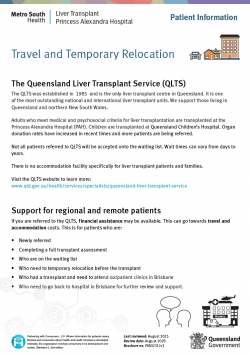The Queensland Liver Transplant Service (QLTS) supports those living in Queensland and northern New South Wales.
Adults who meet medical and psychosocial criteria for liver transplantation are transplanted at the Princess Alexandra Hospital (PAH). Children are transplanted at Queensland Children’s Hospital. Both hospitals are in Brisbane.
Organ donation rates have increased in recent times and more patients are being referred. Not all patients referred to QLTS will be accepted onto the waiting list. Wait times can vary from days to years.
Depending on your place of residence, you may need to travel long distances or temporarily relocate to Brisbane for transplant listing. You may also need to remain in Brisbane after your transplant for 4–12 weeks. There is no accommodation facility specifically for liver transplant patients and families.
If you are referred to the QLTS, financial assistance may be available towards travel and accommodation costs. A subsidy is available to those accessing specialist medical treatment, where it is not available within 50 km of the closest public hospital or public health facility.
Financial assistance is for patients who:
Download the Travel and temporary relocation guide to learn more.

Travel and temporary relocation , 30 Sep 2025, [https://oss-uat.clients.squiz.net/health/services/specialists/queensland-liver-transplant-service/temporary-relocation-guide]
This document is uncontrolled when printed. Before using the information in this document you should verify the current content on https://oss-uat.clients.squiz.net/health/services/specialists/queensland-liver-transplant-service/temporary-relocation-guide.